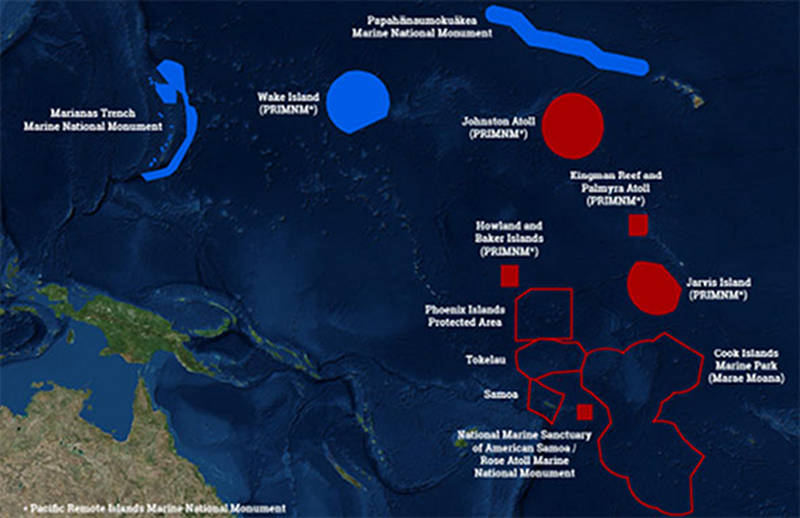

This map shows the U.S. Marine National Monuments in the Pacific Ocean (solid blue and solid red polygons) – the focus of operations for 2015-2017. The 2017 expeditions will take place in the central Pacific, focusing efforts in the vicinity of the Hawaiian archipelago; the Kingman/Palmyra, Jarvis, and Howland/Baker units of the Pacific Remote Islands Marine National Monument (PRIMNM), now known as Pacific Islands Heritage Marine National Monument; National Marine Sanctuary of American Samoa; and Rose Atoll Marine National Monument. Image courtesy of Image courtesy of the NOAA Office of Ocean Exploration and Research, 2017 American Samoa. Download image (jpg, 57 KB).
In January 2017, NOAA Ship Okeanos Explorer embarked on her first expedition of what remains in a three-year effort to investigate the rich biodiversity and dynamic geology in deepwater environments of the U.S. central and western Pacific Ocean. This three-year exploration campaign, titled the Campaign to Address Pacific monument Science, Technology, and Ocean NEeds (CAPSTONE) is systematically collecting baseline information to support science and management needs within and around marine monuments and other protected places in the Pacific and serves as an opportunity for NOAA and the nation to highlight the uniqueness and importance of these national symbols of ocean conservation.
In 2017, scientists will explore southern portions of the Pacific Remote Islands Marine National Monument (PRIMNM), now known as Pacific Islands Heritage Marine National Monument, Phoenix Islands Protected Area (PIPA), Tokelau, and Cook Islands, American Samoa and Samoa, the Johnston Atoll Unit of the PRIMNM, and Musician Seamounts north of the Hawaiian Archipelago.
Operations for the first part of the 2017 American Samoa expedition will begin in Pago Pago, American Samoa, on February 16 and end in Apia, Samoa, on March 2. The expedition will include exploration in the Rose Atoll Marine National Monument, National Marine Sanctuary of American Samoa, offshore (not within) of the National Park of American Samoa, and the waters of both American Samoa and Samoa.
Scientists will be exploring seamounts, possible sites with active hydrothermal vents and associated communities, and sponge and coral communities. This will include mapping Vailulu’u Seamount to look for evidence of change and vent activity since it was last explored in 2005, mapping an area where the seaplane Samoan Clipper was reported lost in 1938 to support future investigation, and collecting biological and geological data to better understand the biodiversity and geological history of this region.
During this expedition, the exploration strategy of NOAA Ship Okeanos Explorer will be employed: bathymetric mapping using multibeam sonar; water column exploration using a Conductivity, Temperature and Depth Profiler (CTD); and remote imaging and video with Deep Discoverer. Scientists from around the world will be participating in the explorations in real time through telepresence technology, and students and the general public can watch and listen to remotely operated vehicle dives in real time on the NOAA Ocean Explorer website.